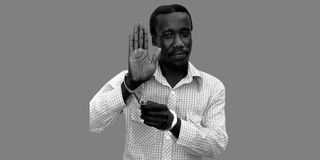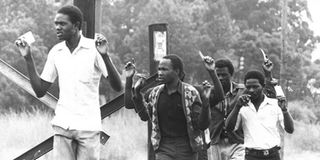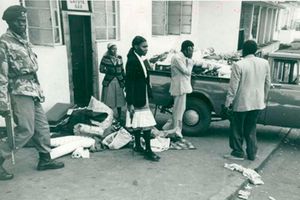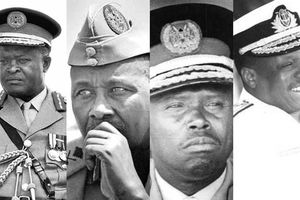
Hezekiah Ochuka after his arrest.
The Kenya Air Force (KAF) is 60 years old. In the ordinary life of a human being, the Service is in the de-accumulation stage. This means that KAF should completely declutter; shed off its old doctrine, obsolete equipment and, most importantly, aspects of its bad history and start anew with fresh ideas, doctrine and disposition to defend Kenya’s air space against emerging and ever evolving threats.
KAF began in 1940 when the British set up a Royal Air Force Station in Eastleigh, Nairobi. The British used the facility to control the air space in Eastern Africa – Kenya, Uganda, Tanganyika, Zanzibar, Seychelles and their other dominions in the region. The station was vital in providing aerial photography of enemy positions during World War II.
In 1964, Parliament enacted a law to establish the Kenya Air Force. British expatriates were invited to help set up the Service. They set up an Air Training School at Eastleigh, currently known as Moi Air Base, to train pilots while air navigators, aeronautical engineers and technicians received training abroad.
By 1973, the service had come of age with adequate local personnel. On April 17, 1973, Colonel Dedan Njuguna Gichuru was appointed the first indigenous Commander of the Service. In 1974, Laikipia Air Base was set up at Nanyuki to house the Tactical Fighting Wing of the Air Force composed primarily of jet fighters.

Civilians caught up in the attempted coup of August 1, 1982 walk on the streets while displaying their ID cards.
In subsequent years, KAF was tasked to establish the Kenya Armed Forces Technical College (KAFTECH), now Defence Forces Technical College (DEFTEC) to train technicians to support combat and logistical units of the three branches of the Defence Forces of Kenya – Army, Air Force and Navy.
Kenya Air Force grew exponentially in its formative years. By dint of its mandate and mission, the service recruits its officers, men and women from the best cadre of recruits who seek to join the Defence Forces.
The crème de la crème of cadets and recruits who score the highest in their aptitude test end up in the Air Force or the Navy. Joining the Air Force to train as a pilot, air navigator or aeronautical engineer is considered prestigious. Inevitably, perceptions of elitism in Kenya Air Force have always been rife in the other branches of the Defence Forces.
Unlike the Kenya Army, which had witnessed a mutiny by 1st Kenya Rifles Battalion in 1964 and an ill-fated coup plot in March 1971, Kenya Air Force had an unblemished tenure of service, which earned its officers, men and women the trust and confidence of their Commander-in-Chief. But this prestigious position of Kenya Air Force was shattered on August 1, 1982 when a group of servicemen led by Private Hezekiah Rabala Ochuka and Senior Sergeant Pancras Oteyo Okumu attempted to overthrow the government of President Daniel Toroitich arap Moi.
Ochuka and his colleagues had formed an amorphous group known as the “People’s Redemption Council” and stormed the Kenya Broadcasting Corporation (then Voice of Kenya) and announced that they had taken over the government.
The rebels ordered the Kenya Police to assume the status of “civilians” and stay at home. Ochuka had stolen and worn the badge of rank and honour of a Colonel during the failed putsch. The rebellion did not last beyond six hours but the blot it occasioned in the history of Kenya Air Force has lasted for decades.
When their mutiny failed, Private Ochuka and Senior Sergeant Okumu hijacked Major Nick Leshan (later rose to a Lieutenant-General) to fly them to Tanzania where they sought asylum but were instead promptly arrested and repatriated to Kenya to face trial. They were subsequently charged with treason, convicted, sentenced to death and hanged on July 10, 1985. Ten other conspirators were sentenced to death and nearly 1,000 imprisoned.
There have always been speculations on why the August 1982 attempted coup failed, mostly by civilians as well as rank and file in other uniformed services of Kenya. The widespread explanation is that the young KAF servicemen who were joined by students from the University of Nairobi got overly excited, drunk, became disorganised and lost the plot to loyal elements of the Kenya Army and the paramilitary General Service Unit.
What is often forgotten is that the putsch was led by low ranking servicemen, regimentally classified and described as “other ranks”. In regimented formations, “other ranks” are trained to obey orders and directions from their commanders. Conversely those in the officer cadre (Lieutenant to General) are trained to provide leadership and command to the “other ranks” which in the case of Kenya Defence Forces begin from the rank of Private to Warrant Officer.
Ochuka and his band may have stolen and worn the badges of rank of their superiors but they did not have the wherewithal, training and disposition to issue effective orders as officers qua officers. This fact is discernible from the accounts of hundreds of officers and servicemen who were arrested and interrogated after the failed coup.
The Kenya Air Force did not just lose its prestige in August 1982. It suffered the ignominy of being “taken over” by the Army and its Commander was tried, convicted and jailed by Court Martial. Kenya Air Force lost its name too. It was renamed “82 Air Force” and its Officers; men and women were subjected to screening; “militarisation” and gruelling drill that is the preserve of the infantry units in the Army.
It also lost the sky and royal blue colours of its uniform and for over 10 years its rank and file dressed in a strange uniform which was something between pink and beige. Since 1982, Kenya Air Force officers, men and women wear the same rank insignia with the Kenya Army. Before then, the rank insignia for the Kenya Air Force was similar to that of the British Royal Air Force. Incidentall,y the Kenya Navy has retained the rank insignia worn by the British Royal Navy.
The respite for Kenya Air Force came in 1994 when the Court of Appeal, which was the apex court in Kenya then, declared that ‘82 Air Force was an illegal entity unknown to law. The presidential proclamation that disbanded the Kenya Air Force and renamed its remaining elements “82 Air Force” was not enacted into law. Kenya Air Force has progressively regained its prestige; old uniform, regimental and presidential colours but the misadventure of its servicemen in August 1982 will always be a blot in the otherwise colourful tenure of service for KAF.
It is a bad history but the recasting the Kenya Air Force has done before turning 60 has helped re-orient the service and toss away the tag of disloyalty. Two of its officers, Generals Julius Waweru Karangi and the late Francis Omondi Ogolla have earned the trust and confidence of their Commander-in-Chief and risen to the apex of the Kenya Defence Forces.
Captain Wanderi (rtd - KAF) is a former Staff Officer, Legal Services, at Kenya Air Force Headquarters (2001-2006)







